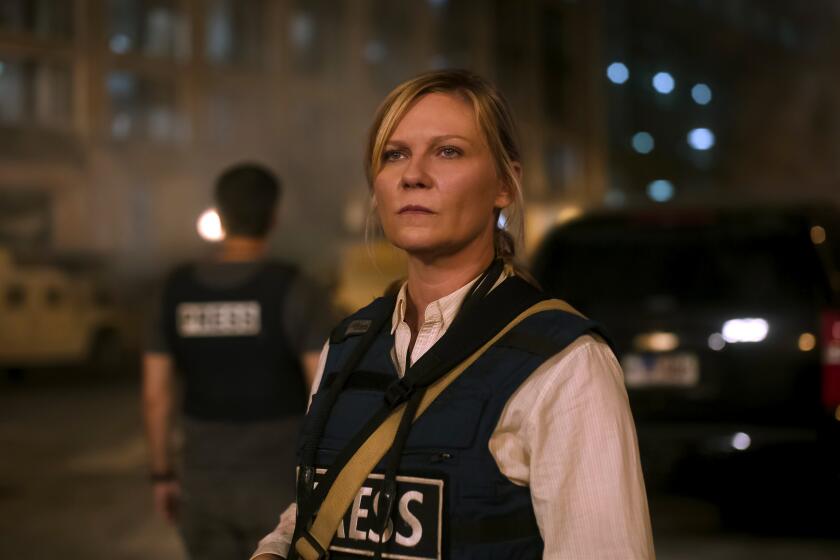Inside the most unnerving scene in ‘Civil War’: ‘It was a stunning bit of good luck’

- Share via
Warning: The following contains spoilers for “Civil War.”
America has been shattered in “Civil War.” An armed alliance between Texas and California known as the Western Forces is on the verge of recapturing a besieged capital. A team of journalists heads from New York City to Washington, D.C., in hopes of landing one last interview with the president, an illegal third-termer gone rogue.
As they make their journey, Lee (Kirsten Dunst), a veteran photojournalist who has witnessed conflicts all over the world, reluctantly takes the inexperienced young Jessie (Cailee Spaeny) under her wing. Lee sees something of herself in Jessie and wants to spare her younger counterpart the disillusionment and dismay she has come to feel. All the work she has done has seemingly led to nothing, as the nation rushes headlong into a hopeless endgame.
Written and directed by Alex Garland, whose previous work includes the pessimistic, dystopian tales “Ex Machina” and “Annihilation,” the film walks a razor’s edge, careful not to tip to one political perspective or another. Often it is unclear who is fighting on which side, as a hypnotic frenzy seems to have overtaken everyone.
Starring Kirsten Dunst and Cailee Spaeny as journalists chronicling a war at home, writer-director Alex Garland’s action film provokes a shudder of recognition.
No scene encapsulates the tricky balancing act of the film quite like one that involves actor Jesse Plemons, appearing in a cameo. Spaeny’s character has briefly become separated from the other journalists she is traveling with, including Joel (Wagner Moura) and Sammy (Stephen McKinley Henderson). When the group finally finds Jessie, she is being held at gunpoint with another journalist in an open field by a small cadre of militiamen who have been dumping dead bodies from a truck into a crude mass grave.
An unnamed soldier of uncertain allegiance played by Plemons seems in charge. As Dunst’s Lee, Joel, Sammy and another journalist try to figure out what to do, the decision is made to approach the soldiers in the hopes of saving Jessie and their colleague.
Plemons’ soldier, wearing a disconcerting pair of red plastic sunglasses while he idly fingers his assault rifle, interrogates the group with unnerving calm. He asks them all to identify themselves with what has already become the signature line of the film: “What kind of American are you?”
He begins to shoot those whose answer he doesn’t like, revealing a blatant racism and xenophobia. As it seems he is about to turn on Jessie, Sammy crashes into the moment in their truck, running down Plemons’ character as they are able to make their escape — though not without losses.
Plemons’ coldblooded psychotic is among the most terrifying things in “Civil War” and his scene is a pivotal one, essentially launching the journalists toward the final act of the movie.
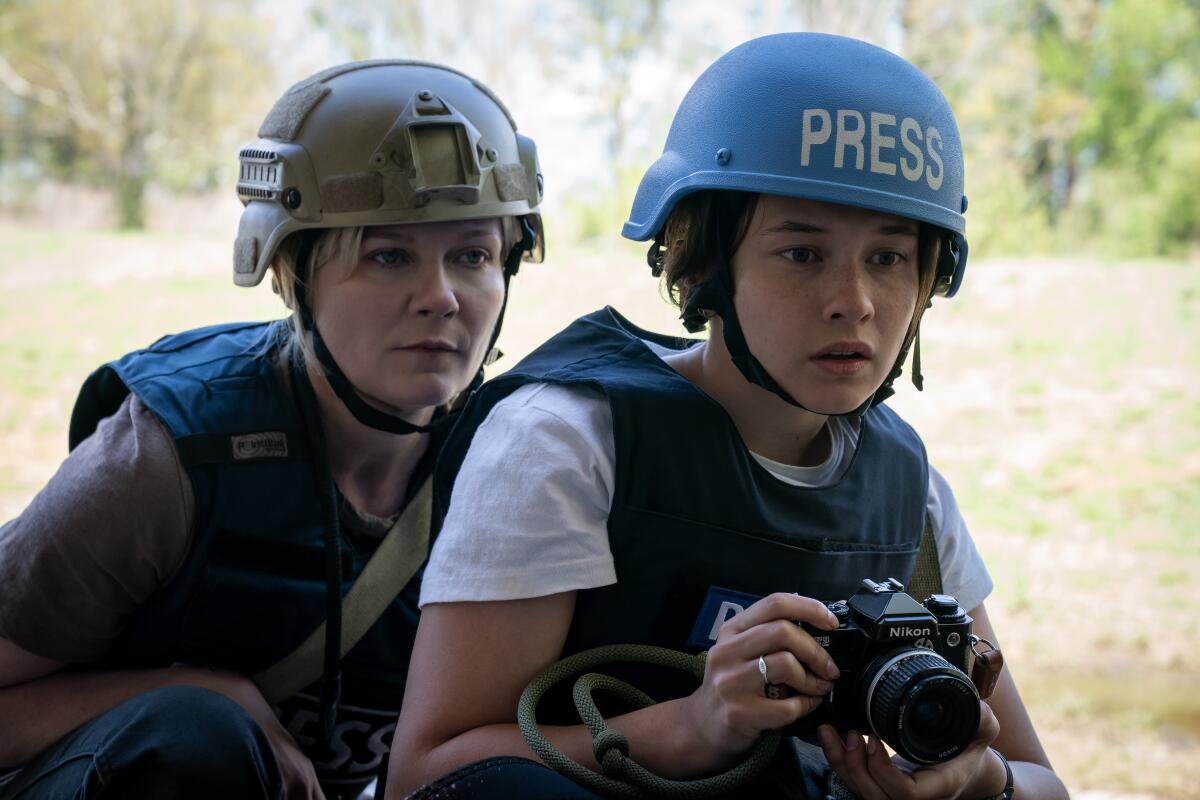
In real life, Dunst and Plemons are married with two children. Having met while shooting a season of the television series “Fargo,” they also appeared together in Jane Campion’s “The Power of the Dog,” both earning Oscar nominations for their performances.
In a recent interview alongside Spaeny, Dunst addressed what it was like to perform with her partner, especially since he had to embody such a disturbing character.
“I feel like Lee’s approach in this scene is: We just gotta get through this and get out alive,” Dunst says. “So I wasn’t scared of him as an actor. It’s a weird question because Jesse and I, we fell in love creatively first as actors and how we work together. And we just love that process.”
Continues Dunst, “I’m going to be very honest — watching him play that role, I was like, ‘Dang, my baby is crushing this role.’ So that’s how I felt. I was like, ‘F—, he’s a good actor.’ The scenario was very scary, but I wasn’t scared of him. But just looking at the mass grave, all of it around me, was terrifying.”
Shooting the scene was nevertheless unique for Dunst, as opposed to the rest of her cast mates. “The other actors and how they were responding to Jesse was more terrifying for me in terms of what was actually happening in the scene,” adds Dunst. “But I also didn’t really interact with him in that scene. Basically, he asked me where I’m from, and I’m like, ‘Colorado.’ So it wasn’t like he was doing things to me like he was to Cailee and the other characters in that scene, which was terrifying because the scenario’s terrifying.”
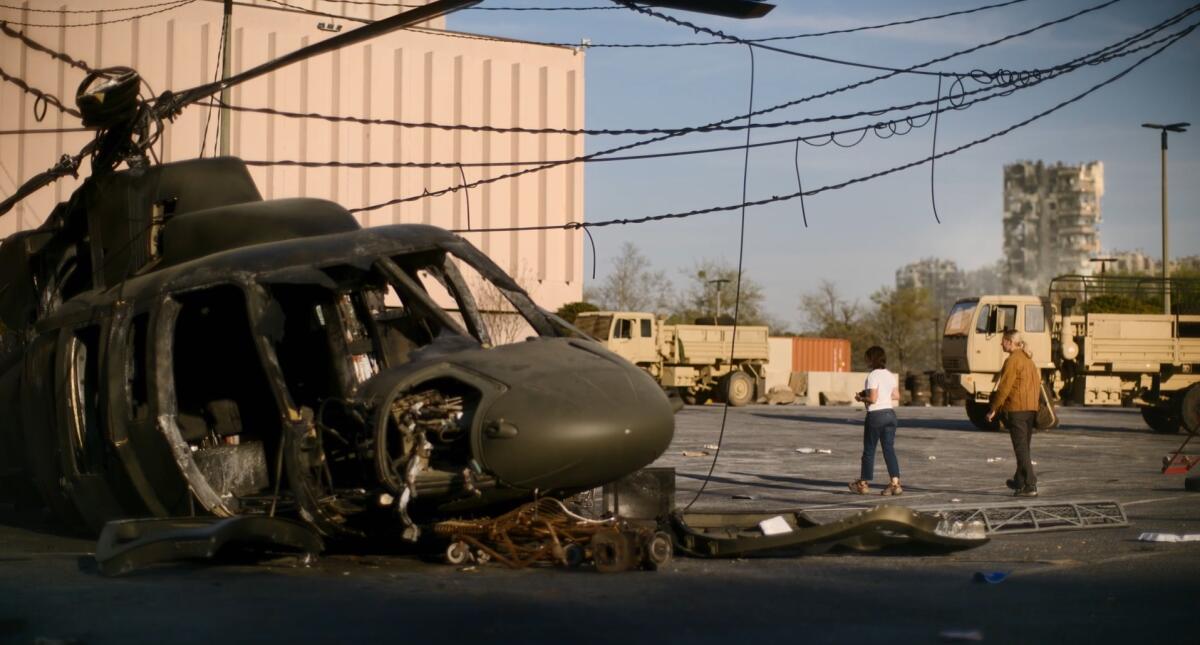
Spaeny’s experience of the scene was very different. Shooting for two days in the hot Atlanta sun began to take its toll on her. The film was shot chronologically, so the events of the film did start to have an cumulative weight on the actors.
“Once we got to that scene, it was very scary for me,” says Spaeny, explaining that the first part of the scene focused on Dunst, Moura and Henderson planning a rescue from afar while she and Plemons were away from everyone else. ”So I was down there with Jesse for about a half a day with him, completely in character, drilling me, improvising that whole scene.
“And so by the time we got to the end of that scene, I think we were all really out of it. You do it that many times and it just sort of gets under your skin.”
Spaeny went on to explain that Garland and cinematographer Rob Hardy had designed the scene so that no cameras were visible, with Hardy hiding in the pit that was meant to be a mass grave.
“And so you weren’t seeing some crew guy wandering in the background eating a bag of chips — you didn’t have a traditional close-up,” says Spaeny. “It felt very immersive. That stunt sequence was incredible. And by the time we all got into that car, when Stephen comes and picks us up, God, it felt really real. That whole sequence. The scene, the way it’s written is just completely chilling. And then the performances that I was surrounded by, it was just that combination, doing it over and over again for two days straight. It just gets to you.”
Plemons was not Garland’s first choice for the role. About a week before principal photography began, another actor cast in the role whom Garland declines to name had to drop out. Garland recalls learning he had lost the other actor while on the phone outside the rehearsal space where the cast was preparing.
“I was standing out on the street when I got the call and I thought, ‘Oh s—. Now, now we’re in trouble,’” says the director. “And so I went to the rehearsal and said ‘Bad news, guys, so and so can’t do it.’ And Kirsten said, ‘What? You should ask Jesse.’ And I thought, Oh, that would be amazing.”
“Jesse was around,” says Dunst. “I was like, ‘Let’s just ask Jesse to play this role.‘”
“It was a stunning bit of good luck,” says Garland. “That makes it sound like I’m being disrespectful to the other actor. I’m not at all. It’s just the film was very lucky to get Jesse.”
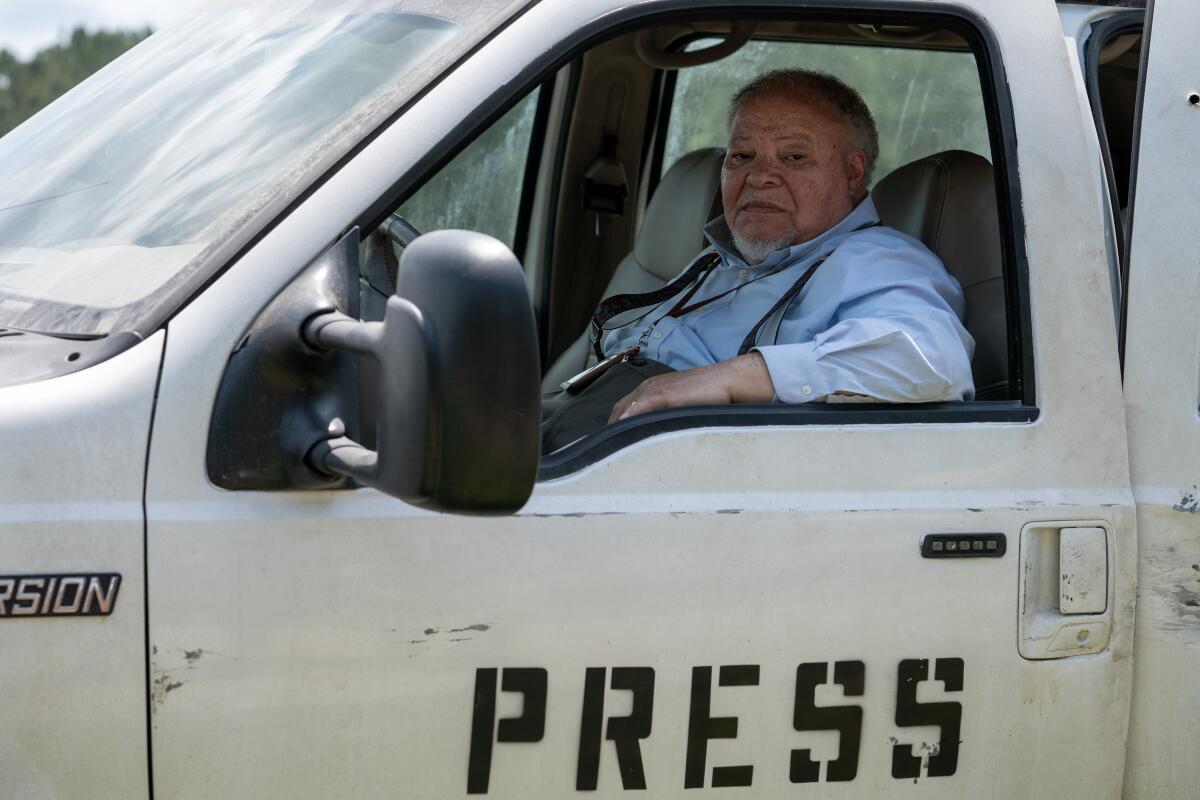
The climactic moment of Plemons’ scene, when a truck takes him out, is triggering wildly disparate reactions. At the film’s world premiere at South by Southwest, an audience in one theater gave it a roaring cheer while another theater’s crowd sat in stunned silence.
As they continue on, Sammy reveals he has been shot. By the time they get to the relative safety of a military encampment of the Western Forces, he is dead. Lee later looks at her camera, seeing a photo of Sammy’s body slumped in the backseat of their vehicle. In a moment of fraught tenderness, she deletes it.
“We shot that scene a lot of different ways: I don’t delete it, I delete it, I was crying, I wasn’t crying,” Dunst remembers. “There were many different versions of that. And that’s the version that Alex wanted to tell for Lee’s character. So the decision was made for me in the edit because we just did a bunch of different choices.”
Dunst recalls working through the emotions of the moment. “I would just put myself in Lee’s shoes,” she says. “If a mentor for me, if I was with them during their death — whatever that meant for me. But I think the decision for Lee was to keep that for herself in her memory. And she didn’t need a photo. It’ll be a photo in her brain for the rest of her life.”
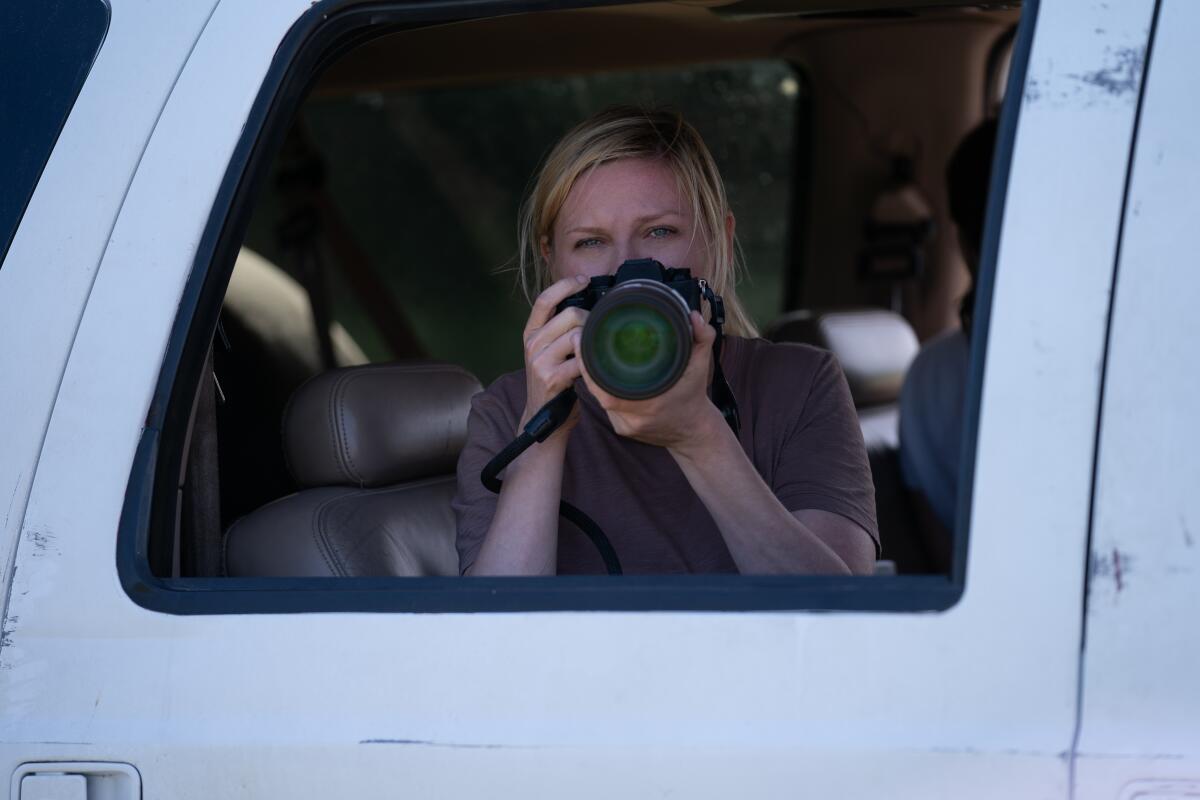
In an early scene in the movie, one of the first pieces of advice that Lee gives to Jessie is to wear a helmet. And during a firefight early in the film, Dunst, Spaeny and Moura are indeed all wearing helmets. But then they never wear them again, even during the climactic military attack on the White House.
“We’re just saying we lost them,” explains Dunst with a knowing smile. “That was a big debate, believe me. And I don’t know how much I should share, but basically, for cinema, we weren’t totally sure if you wanted to see your characters through the whole movie in helmets.
Dunst says she thought she looked like Goldie Hawn in “Private Benjamin” when wearing her helmet. Spaeny had concerns of her own.
“You can’t see my eyes,” she says with a small laugh. “It’s realism until the point you can’t see my face.”
Part of what makes “Civil War” so powerful is how plausible it is, depicting people in rare moments at their best but more often at their worst, riven by self-interest and small-minded fears. The film’s bracing sense of reality also leads to a deep concern for these journalists urgently heading toward danger, helmets on or not.
“It was a cinematic choice with that one,” Dunst says. “I feel like in every other thing, we tried to make it as real as possible.”
More to Read
Only good movies
Get the Indie Focus newsletter, Mark Olsen's weekly guide to the world of cinema.
You may occasionally receive promotional content from the Los Angeles Times.
